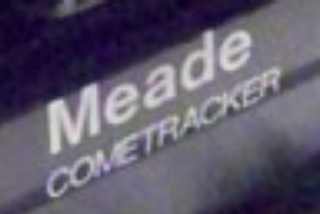
|
The Meade 622 Cometracker
Comet Astrograph
Main page for images and equipment
|
Updated 2/21/16
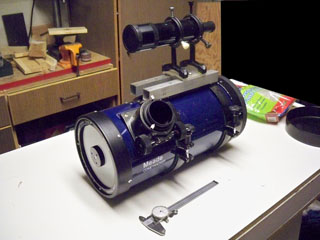 |
Pictured
at left is a bit of astronomical history. Let me briefly tell
you the story. Back in 1985, Celestron brought out the 5"
"Comet Catcher", a cheap Schmidt Newtonian to view
(only) the upcoming Comet Halley. Not to be outdone, Meade jumped
on the bandwagon and brought out a bigger, badder, and more capable
SIX inch Schmidt Newtonian. This scope was built like a tank
- it had a steel tube, 2 inch low profile 2" focuser for
viewing and imaging, and a solid cradle, finder, and looked
fantastic. I should have bought one back then! But I waited and
it was soon discontinued right after the comet had gone by.
Ten years later,
I found one for sale on Astro mart - the first time I had ever
seen a used on for sale in a decade. I contacted the seller,
and it was in mint condition in all the original wrappers and
had all the original accessories. And after a lot of discussion,
it was mine for what I considered to be an excellent price. I
soon set up the scope, wrestled with the collimation with the
specially offset secondary and used this instrument for some
of my very first ST237 CCD images. It was fast, sharp and easily
covered the smaller field of the 237 chip.
|
| A
few months ago, I started to refurbish this instrument, which
was sitting stored in the corner of the wash room unused. A year
ago I had stripped the coatings off the mirrors in an attempt
to build a prototype solar scope, but that did not work too well
as solar newts have very poor contrast by nature. My goal was
to use this instrument on comets, and with the bigger chip ST10xme.
The optical tube assembly was torn down, and mirrors were sent
off to Majestic Coatings in New Jersey. In a week the mirrors
were back, and I built a new mirror cell to mount the thin mirror
with out warping it like the Meade cell did so well. Collimation
is now a snap with the laser collimator! Finally, on February
12, this year I mounted it up next to my 10 inch in the backyard
observatory and took the very first test images. Wow! Using the
Baader coma corrector did the trick and the stars were sharp
all across the entire ST10 field. I hope to use this for bright
naked eye comets and many larger deep sky object with its big
1.5 degree field. |
|
Here are
a few more images of the setup:
Left: View down
the front of the corrector plate. See the huge half inch offset
in the secondary mirror? This is to catch all the marginal rays
of the fast primary. You cannot eye ball the collimation with
this scope.
Center: Mirror
cell ready for mounting the mirror. Silicone rubber pads at the
70% zone in three places holds it firmly and without any warping
what so ever. The pads are silicone adhesive spaced with the
three 1/8" Masonite pads. They are removed when the glue
is solidified, thus floating the mirror very firmly onto the
urethane coated birch hard wood cell.
Right: Mounted
on the plate I use for other scopes next to the 10 inch. It is
guided with the Vixen 80mm in the background. The original focuser,
which was one of the worst rack and pinions in existance was
replaced with a precision helical cut unit.
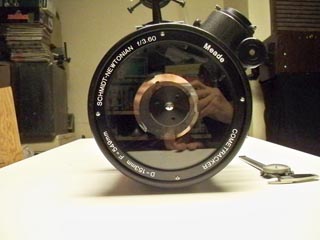
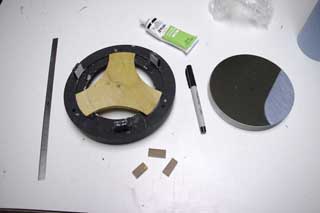 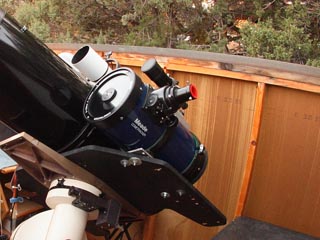
Finally a fish
eye close up of it mounted on the 10 inch.
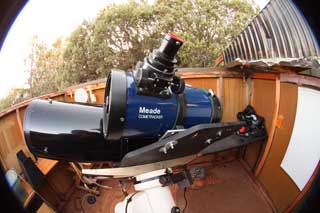
|
 And now here are some images with the new 6" Astrograph:
And now here are some images with the new 6" Astrograph:
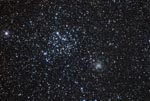 M35 and NGC2159
clusters in Gemini
2/14/16
M35 and NGC2159
clusters in Gemini
2/14/16
|
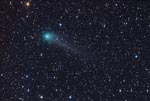 Comet Catalina US10
First comet with newly
refurbished 6" f/3.6
Comet Catalina US10
First comet with newly
refurbished 6" f/3.6
|
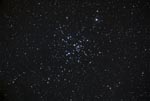 M41
Full Moon tests of
Maxim DL v.6
with 6" f/3.6
2/20/16
M41
Full Moon tests of
Maxim DL v.6
with 6" f/3.6
2/20/16
|
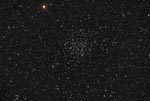 M46
Full Moon tests of
Maxim DL v.6
with 6" f/3.6
2/20/16
M46
Full Moon tests of
Maxim DL v.6
with 6" f/3.6
2/20/16
|
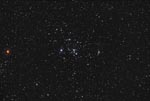 M47
Full Moon tests of
Maxim DL v.6
with 6" f/3.6
2/20/16
M47
Full Moon tests of
Maxim DL v.6
with 6" f/3.6
2/20/16
|
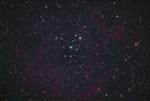 NGC2244
Full Moon tests of
Maxim DL v.6
with 6" f/3.6
2/20/16
NGC2244
Full Moon tests of
Maxim DL v.6
with 6" f/3.6
2/20/16
| | | | | | | | | |
| | | | | | | | | |
HOME GALAXIES EMISSION NEBS REFLECTION NEBS COMETS
GLOBULARS OPEN CLUST PLANETARIES LINKS

|